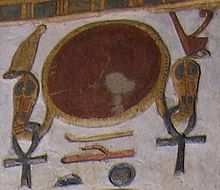*Seh₂ul and *Meh₁not
This article should specify the language of its non-English content, using {{lang}}, {{transliteration}} for transliterated languages, and {{IPA}} for phonetic transcriptions, with an appropriate ISO 639 code. Wikipedia's multilingual support templates may also be used. (January 2024) |
| *Seh₂ul | |
|---|---|
Sun Goddess | |
Mēness | |
| Germanic equivalent | Máni |
*Seh₂ul and *Meh₁not are the reconstructed Proto-Indo-European goddess of the Sun and god of the Moon. *Seh₂ul is reconstructed based on the solar deities of the attested Indo-European mythologies, although its gender (male or female) is disputed, since there are deities of both genders.[1] Likewise, *Meh₁not- is reconstructed based on the lunar deities of the daughter languages, but they differ in regards to their gender.
The daily course of *Seh₂ul across the sky on a horse-driven chariot is a common motif among Indo-European myths.[note 1] While it is probably inherited, the motif certainly appeared after the introduction of the wheel in the Pontic–Caspian steppe about 3500 BC, and is therefore a late addition to Proto-Indo-European culture.[3]
The Sun deity
*Seh₂ul is reconstructed based on the Greek god
In the mythologies of the daughter languages (namely, Baltic, Greek and Old Indic), the sun deity crosses the sky in a horse-driven chariot or wagon. However, Mallory and Adams caution that the motif is not exclusively Indo-European, and mention evidence of its presence in Mesopotamia.[8]
A character related to the Sun deity is the 'Sun-maiden'.[9] Mallory and Adams cite as examples 'Saules meita', the daughter of Saulé in Baltic tradition, and Sūryā, daughter to Indic Sun god Sūrya.[10] However, both scholars, as well as Martin L. West, also posit Helen of Troy, from Greek mythology, was another example of the 'Sun-maiden'.[7][11]
The Moon deity
*Meh₁not- is reconstructed based on the Norse god
Alternative myth

Although the sun was personified as an independent, female deity,[20] the Proto-Indo-Europeans also visualized the sun as the "lamp of Dyēws" or the "eye of Dyēws", as seen in various reflexes: "the god's lamp" in Medes by Euripides, "heaven's candle" in Beowulf, or "the land of Hatti's torch", as the Sun-goddess of Arinna is called in a Hittite prayer;[21] and Helios as the eye of Zeus,[22][23] Hvare-khshaeta as the eye of Ahura Mazda, and the sun as "God's eye" in Romanian folklore.[24] The names of Celtic sun goddesses like Sulis and Grian may also allude to this association: the words for "eye" and "sun" are switched in these languages, hence the name of the goddesses.[25]
Egyptian mythology is unrelated to Indo-European mythology so there is unlikely any historical link, but the metaphor of Eye of Ra was used in it too.
See also
Notes
- Pahlavi Bundahishn narrates that creator Ohrmazd fashioned the sun "whose horses were swift".[2]
- ^ In Ukrainian myth, like in Baltic tradition, the moon, Myesyats, is a male god[12] and said to marry the Sun goddess.[13]
References
- ^ West 2007, p. 195-196.
- ISBN 9780190879044
- ^ Fortson 2004, p. 23.
- ^ O'Brien, Steven. "Dioscuric Elements in Celtic and Germanic Mythology". In: Journal of Indo-European Studies 10:1–2 (Spring–Summer, 1982), pp. 117–136.
- ISBN 978-0-86516-510-6.
- ^ a b c Gamkrelidze & Ivanov 1995, p. 760.
- ^ a b Mallory & Adams 1997, p. 232.
- ^ Mallory & Adams 1997, p. 278.
- ^ West 2007, p. 227-232.
- ^ Mallory & Adams 1997, p. 556.
- ^ West 2007, p. 230-231.
- ISBN 978-1-136-14172-0.
- ISBN 978-1-57607-130-4
- ^ Mallory & Adams 1997, p. 385.
- ^ ISBN 978-04-15340-18-2
- ISBN 0-19-869117-3
- ^ Beekes, Robert (1982). "Gav. må, the Pie word for 'moon, month', and the perfect participle" (PDF). Journal of Indo-European Studies. 10: 53–64.
- .
- ISBN 978-04-15340-18-2
- ^ Mallory & Adams 2006, p. 427.
- ^ West 2007, p. 195.
- .
- ISBN 9781316673270.
- Bibcode:2012RoAJ...22..155I.
- ISBN 0-19-280120-1pp.10, 16, 128
Sources
- ISBN 1-4051-0316-7.
- Gamkrelidze, Thomas V.; Ivanov, Vjaceslav V.(1995). Winter, Werner (ed.). Indo-European and the Indo-Europeans: A Reconstruction and Historical Analysis of a Proto-Language and a Proto-Culture. Trends in Linguistics: Studies and Monographs 80. Berlin: M. De Gruyter.
- ISBN 978-1-884964-98-5.
- Mallory, James P.; Adams, Douglas Q. (2006). The Oxford Introduction to Proto-Indo-European and the Proto-Indo-European World. Oxford, England: Oxford University Press. ISBN 978-0-19-929668-2.
- ISBN 978-0-19-928075-9.
